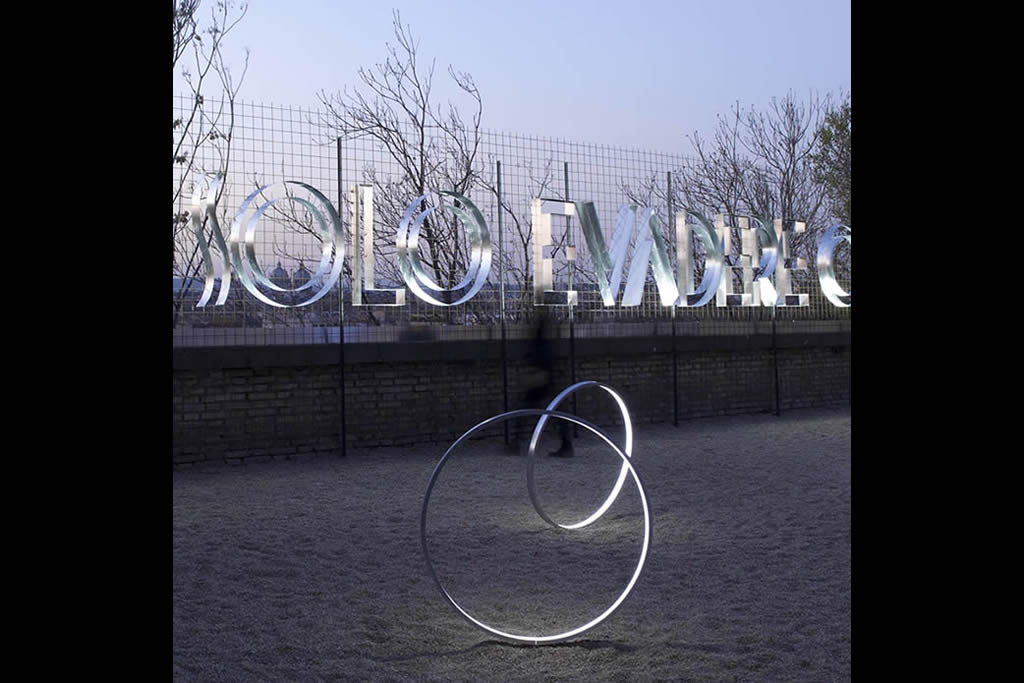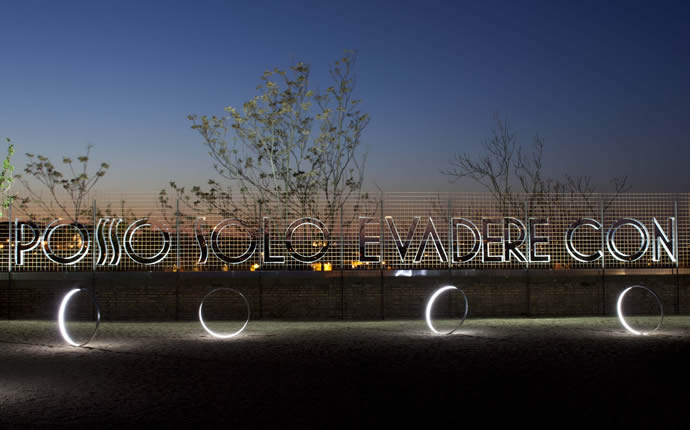Blind gymnastics – the race towards the circle
An exercise in freedom | 30 marzo – 30 maggio 2012
ELENA MAGINI
The intervention proposed by Marzia Migliora for the Gardens of Saint Alessio is presaged by some of the various expressive forms which are recurrent in her work: the extensive use of language, the relationship between the space and the retracing of its history, an interest in a deficit and its dysfunction.
Heterogeneous suggestions represent the matrix of a starting point for a work which develops through mechanisms of subtraction: the artist invites in this manner the viewer to reflection and towards a redefinition of their own singular perspective, through the assumption multiple points of view.
In Blind Gymnastics-The Race Towards the Circle Migliora takes her start from the garden’s history and from its current configuration – understood as a combination of topographic and socio-cultural characteristics – to give life to a three part work, with a strong visual and conceptual impact, where space assumes the ambivalent aspect of subject and spatial experience for the viewer.
The artist reviews the concepts of superstructure and external imposition, limit and absence, through a reflection favored by elements tied to the living history of the site.
Now used as a refuge by immigrants and the homeless, at the end of the 1800s the gardens were incorporated by an institute for the blind; used as an area for play and recreation by the young guests of the institute, it represented a place of aggregation and of escape from the strict rules imposed by the internal structure.

Other elements which fascinated the artist are the historical and political happenings which revolved are the hills of Aventine were the Gardens of Saint Alessio are found: these were, in fact, the site of the Secessio Plebis, famous for the battle between the patricians and the plebeians during the period of the Republic of Rome which, centuries later, would be called “The Aventine Secession”.
The focus here however is not so much on the reconstruction of past events, but on recreating, in a sort of historical and contemporary short circuit, the specifics of the gardens, as felt by the artist in its being a “theatre for the attempts to gain freedom and to escape obligations”.
In the installation Libero Come Un Uomo, Migliora constructs a metal fence which physically encloses the gardens at their only outlook towards the city, the lookout, creating an architectural and tangible limit to a space which usually has other connotations.

The artist works on the idea of deficit, placing the viewer in front of a fence, which impedes the view. The only opportunity for the viewer to see the view is a linguistic element, a quote by Samuel Beckett taken from a letter addressed to his friend, the violinist Morris Sinclair, which states the phrase “I can only escape with my eyes tightly shut” cut out of the mesh, it allows a crossing of the structure through sight.
Aside from the connotations of the material used (a reticulated mesh, alluding to a cage and, symbolically, a state of escape is dictated by an apparent impediment.
The “eyes tightly shut” are also a metaphor for a condition aside from the inability to see, that of sleep, intended as a suspension of activity and the consequent opportunity to reflect, and that of dreaming, interpreted as the construction of an alternate reality, an escape from the contingency.
Sight is further perceived by the artist as not only a physiological fact, but also as a “voluntary act by people with sight”, connected, therefore, to an element of knowing and experience.
For Migliora it is fundamental proving how a physical deficit, the dysfunction implied by the evocation of the condition of blindness, is potentially a condition for an “alternate vision”, suggesting the possibility of experiencing and knowing reality through elements other than sight.
In Rooling Hoops Migliora places on the ground adjacent on the ground. The precise positioning of the elements is taken from an image found in documents from the institute’s archives, which shows children in a moment of recreation, intent on playing with the circles. The re-proposal of the exact position of the rings in the photo, in an apparent dynamic, gives the objects, which have been voided of their functionality, a possible meaning, accessible albeit only through the imagination or fantasy: the viewer is invited to reconstruct the scene imagining it, gleaning from it the original recreational meaning which the artist likens to an obvious and natural form of escape.
Completing Migliora’s intervention is a sound installation, Between 3pm and 5pm, 10; that is, the sound of a bell repeated every day, twice a day, for nine seconds. The source of the sound, a brass bell, is hidden from view and is intended, as such, as another immaterial element which, similar to the linguistic element in Free as a Man or to the surrender of the absent human form in Rooling Hoops, expounds the process of erasure and subtraction which is the artist’s form of expression. In Between 3pm and 5pm, 10 a recreational dimension is again suggested, evoked by the sound of the bell as a familiar announcement of recreation and diversion; at the same time, the signal, surrounded by other external commentary, resounds in the space as a sort of alarm, demanding a state of attention and of consequent listening and participation.
In Blind Gymnastics-The Race Towards the Circle the single elements, belonging to the different senses, are connected to each other in a tight web of cross references and analogies giving way to an intellectual dimension made from past reminiscences and actual suggestions. In this work sight, play, imagination and escape are fashioned as an unorthodox system, which brings one to the construction of an alternate reality through alternate logic. The “renewed vision” on the existing, put forward here by Marzia Migliora, is contrasted to the multiple superstructures imposed – be they physical, mental, cultural or political – through the possibility to think and reflect.
PROBONO ONLUS
The Garden of Saint Alessio is a site of high historical landscape value. The artist has been invited to confront herself with the values which originate from the complex relationship between architecture, history and landscape, through and inedited encroachment of the territory, which is exemplary unique.
The impediment, not being able to see, creates a condition which gives access to freedom and imagination which together are an indictment towards those who choose to keep “their eyes shut” in the face of that which they do not wish to see.
The work in itself decrees a condition of sameness between human beings inviting everyone indiscriminately to “experience” and imagine, to search for one’s own freedom, to be supportive and to help those who need assistance.
Chiara de’ Rossi, Marina Cimato, Anna Butticci
THE BLIND GYMNASTICS – THE RACE TOWARDS THE CIRCLE, 2012
- FREE LIKE A MAN: Metal fence, mt 30 x 3, with inserted letters with background illuminated
- ROLLING HOOPS: 11 Rolling hoops in alluminium, h mt 1,00, led lightened
- FROM 3 PM TO 5,10 PM: Sound installation, brass bell, timer 2 (9”/24h)